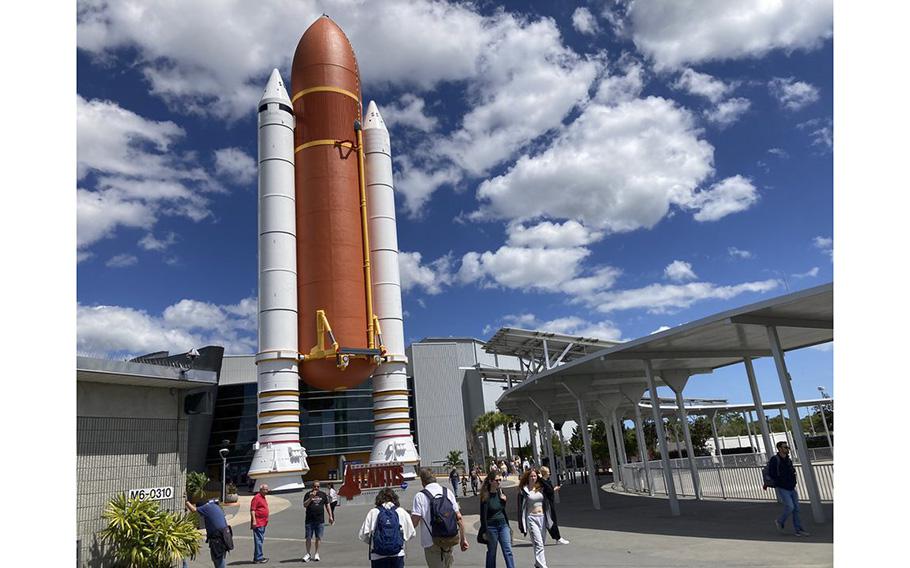
Life-size reproductions of the rocket boosters and external fuel tank that powered space shuttle Atlantis, at the Kennedy Space Center Visitor Complex in Florida. (Susan Glaser/TNS)
MERRITT ISLAND, Fla. (Tribune News Service) — The consoles lit up in the front of the room, the windows rattled from the back. The countdown began and — in 3-2-1 — Apollo 8 was airborne, blasting off into space.
The year was 1968 and, over the next six days that December, astronauts Jim Lovell, Bill Anders and Frank Borman would become the first people to orbit the moon.
Moments after blast off, I was face to face with Saturn V, the massive rocket that powered Apollo, hanging horizontally from the ceiling, the only way it could possibly fit indoors.
The dramatic moment and numerous others like it are re-created on the grounds of the Kennedy Space Center Visitor Complex, the vast exhibition of space memorabilia and attractions on Florida’s east coast.
Kennedy has been a tourist destination since late 1963 — almost as long as it’s been a center for space flight — drawing millions of visitors annually.
It’s an experience that is at times dramatic and jingoistic, other times emotional and somber.
NASA’s new Artemis program, which promises a return to the moon in 2025, has injected new energy into the center.
Indeed, just a few weeks after my visit, NASA announced the four astronauts who are scheduled to travel around the moon next year — the agency’s first moon crew in more than half a century.
“Things are about to accelerate,” one guide told me. “In the next decade, you’re going to see a lot happening at Kennedy Space Center.”
It’s an ebb and flow that has existed for decades.
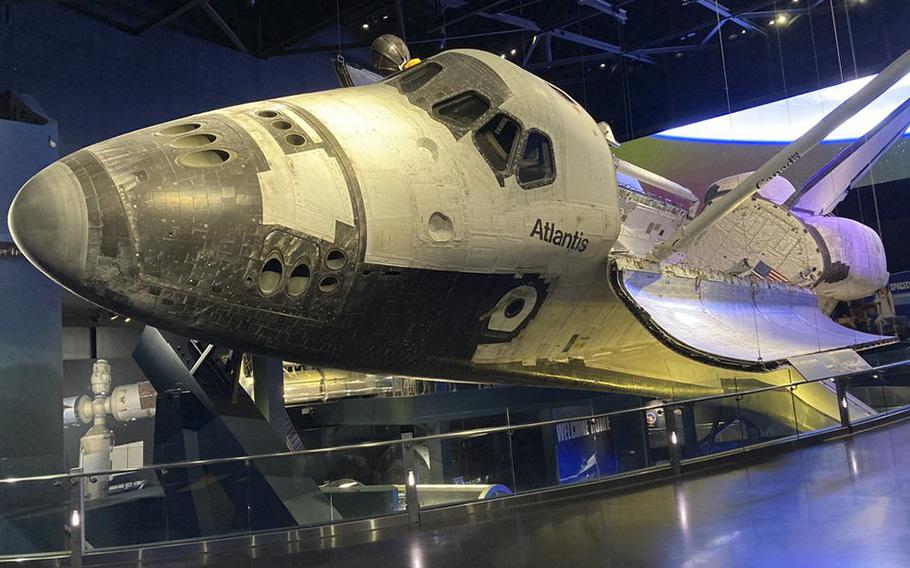
Space shuttle Atlantis, which last flew in space in 2011, is displayed at Kennedy Space Center Visitor Complex in Florida. (Susan Glaser/TNS)
The complex experienced a dip in attendance years ago, after NASA shuttered the space shuttle program in 2011.
“People thought nothing was happening,” said Rebecca Burgman, communications manager for the visitor complex. “When the shuttle program was retired, there was a public notion that NASA and the Kennedy Space Center were shut down.”
Then, two years later, Kennedy was awarded one of the retired shuttles – Atlantis – and created an elaborate display to showcase the vehicle.
More recently, the Artemis program, as well as frequent rocket launches by Elon Musk’s SpaceX and other private companies, are renewing interest in Kennedy as a destination.
“We have more than 80 launches this year,” said Burgman. “That’s a bucket-list type draw for a lot of people.”
Indeed, there was a rocket launch on the evening of my visit, which I watched from nearby Cocoa Beach.
The center recommends two days to see everything that’s here, from rockets and astronaut suits to space ships and moon rocks. I only had one, so I packed it full.
Revisiting the Apollo program
The best way to experience the center might be chronologically, starting with the Apollo/Saturn V Center, which chronicles the early years of the U.S. space program, including President John F. Kennedy’s famous “We choose to go to the moon” speech in 1962. (The space center, by the way, was named after Kennedy after his death in 1963; prior to that, it was called NASA Launch Operations Center.)
The Apollo/Saturn V Center requires a short bus ride from the visitor center complex, so it’s best to do this early – before the bus lines grow too long. Entrance to the exhibit is via a brief film and the re-created Apollo 8 Firing Room, where visitors will feel like they’re reliving liftoff on Dec. 21, 1968.
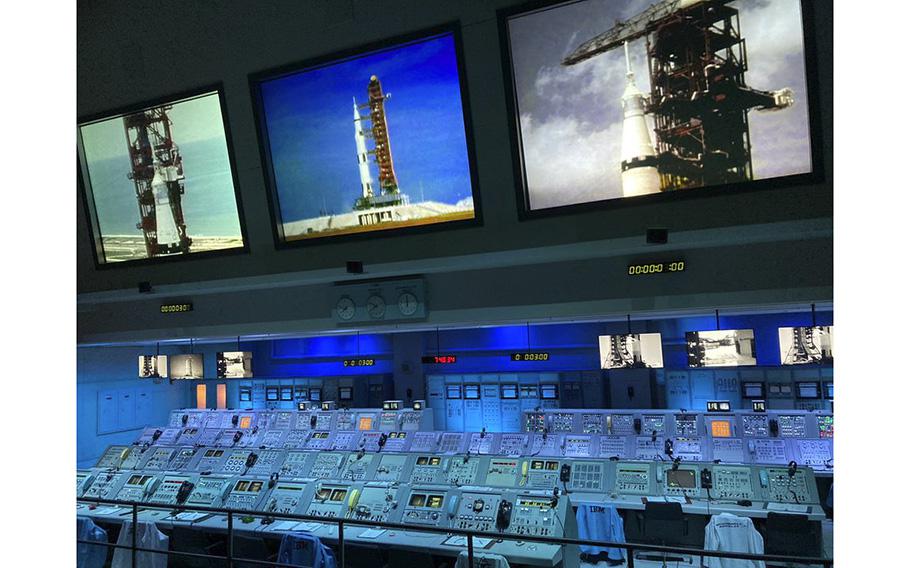
Mission control during the Apollo 8 launch in 1968 is re-created at Kennedy Space Center Visitor Complex in Florida. (Susan Glaser/TNS)
There are numerous artifacts here, in addition to the 363-foot-long Saturn V hanging from the ceiling. Other memorable pieces:
• Alan Shepard’s moon-dust-covered spacesuit from 1971.
• Several moon rocks, collected in 1971 and 1972, including one you can touch. (“Feels like metal,” said my husband.)
• A moving tribute to the astronauts of Apollo 1, who were killed during a fire on the launch pad during a pre-flight test in 1967.
A second theater at the back of the building recounts Neil Armstrong’s dramatic first steps on the moon. Don’t miss it.
Exploring Atlantis
Back at the main complex, make your next stop the Space Shuttle Atlantis exhibit. It’s hard to miss — look for the enormous replica rocket boosters out front alongside the bright-orange external fuel tank.
Again, a short film is used to build up drama for the shuttle program, which was developed to “launch like a rocket and land like an airplane.” Even better, it was reusable.
The actual vehicle – technically, it’s a shuttle orbiter not a shuttle – is enormous and enormously impressive, 122 feet long with a wingspan of 78 feet. Visitors can walk around and under the vehicle, peering inside the payload and inspecting its worn, exterior tiles, which protected the shuttle (and its occupants) from extreme heat upon reentry.
“It was a space truck,” said guide Lee Wilson. “It was designed to bring people and cargo to space.
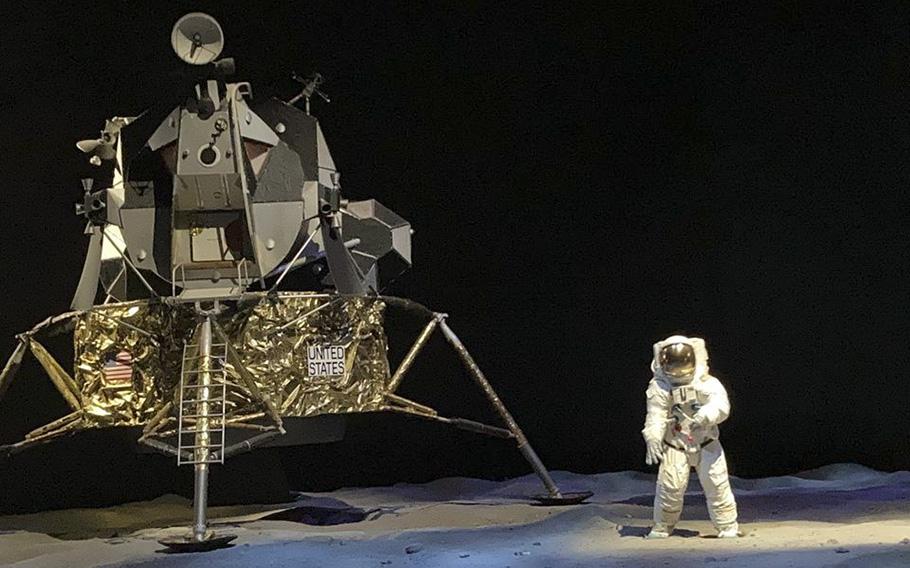
Neil Armstrong's first steps on the moon in 1969 are brought to life at the Kennedy Space Center Visitor Complex. (Susan Glaser/TNS)
He added, “A lot of people want to know how we got the shuttle in here. We built the building around it.”
Also in this building: models of the International Space Station and Hubble Telescope, plus exhibits on how astronauts eat, sleep and go to the bathroom. (Answer: very carefully).
And don’t miss: The Shuttle Launch Experience, an 8 ½-minute simulated launch into orbit, developed by shuttle astronauts and narrated by veteran commander Charles Bolden.
After a prelaunch briefing, riders are strapped in and rotated, the engines ignite and the seats shake as the shuttle lifts off and accelerates. Eventually, the rocket boosters drop off and the ride smooths out — we’re traveling at 17,500 mph, with a view of Earth at 292 miles aloft.
Note: This is not a thrill ride like a roller coaster, but rather a realistic simulation of a shuttle launch, with video and audio that is suitable for most children and even those prone to motion sickness.
Finally, on the first floor of the building, is Forever Remembered, which honors the 14 astronauts killed in the Challenger (1986) and Columbia (2003) disasters. Judith Resnick, the Akron astronaut who was aboard Challenger in 1986, is honored here, with a case holding her flight suit, piano music and a scientific paper she co-authored.
Wilson, when asked why the shuttle program was canceled in 2011, offered this honest answer: “We built five and there were only three left.”
Future of space travel
The center’s newest building, Gateway, debuted last year and is focused on the future of space travel. This is where you’ll find information and artifacts from the private companies operating at Kennedy, including SpaceX and Boeing.
On display here: a SpaceX Cargo Dragon, the first commercial spacecraft to deliver cargo to the International Space Station, in 2012; a Boeing Starliner capsule and spacesuit; and a walk-through deep-space habitat, with zero-gravity dining and sleeping quarters, space for research and more, developed by Lockheed Martin.
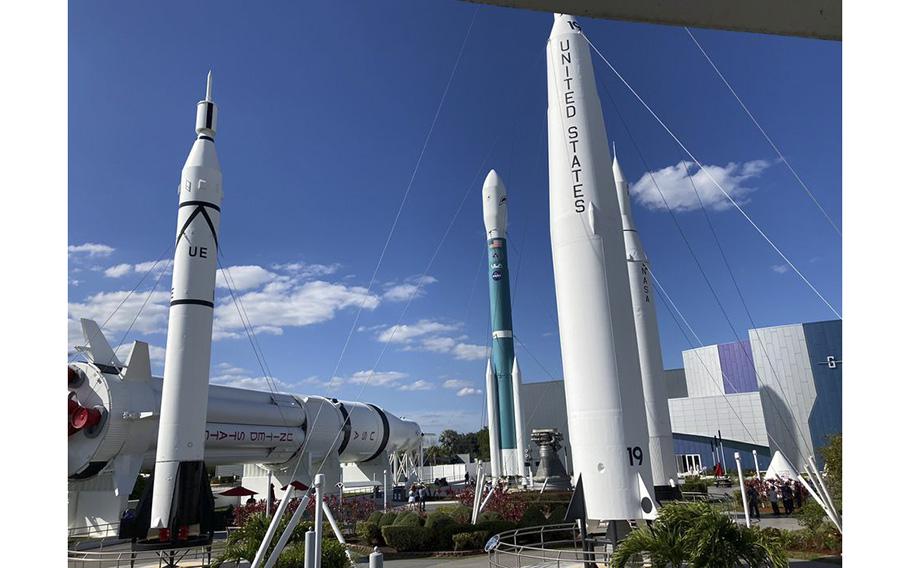
The Rocket Garden at Kennedy Space Center Visitor Complex features numerous retired – and massive – rockets. (Susan Glaser/TNS)
This is also where NASA’s Artemis program, which promises a return to the moon and then Mars, is discussed in depth. On display: an Orion capsule, built for deep space exploration, which flew a test flight in 2014.
Also here: four more simulator rides, included in admission: Red Planet, Daring Explorers, Cosmic and Unchartered Worlds.
Heroes and Legends
And for my final stop, I toured the Heroes and Legends building, added in 2016.
The Mercury Seven – America’s first astronauts – are honored here, including numerous artifacts from John Glenn, the native Ohioan who was the first American to orbit Earth.
Glenn’s Friendship 7 flight in February 1962 is retold to dramatic effect, with video footage of Glenn in his space suit, and the original Mercury Control Center in the foreground.
Glenn artifacts on display here include his orbital map, flight goggles, helmet and gloves.
Additional exhibits here are geared around some of the characteristics that define America’s space pioneers: passionate, curious, inspired, tenacious, disciplined, confident, courageous, principled and selfless.
The Astronaut Hall of Fame is located here, as well, honoring more than 100 space explorers. The Mercury Seven – Scott Carpenter, Gordon Cooper, Gus Grissom, Walter Schirra, Alan Shepard, Donald Slayton and Glenn – were the very first inducted, back in 1990.
Meet an astronaut and other cool extras
The Visitor Complex offers lots of add-on experiences, including behind-the-scenes bus tours, astronaut meet-and-greets, rocket launch viewings and more.
I took a break from touring to attend a Chat with the Astronaut event featuring Bob Cenker, a Pennsylvania native who flew aboard the space shuttle Columbia in January 1986.
He talked about eating in zero-gravity — “Soup was easy,” he said, “you could drink it.” Crackers were more of a challenge.
Sleep, too, was complicated. One of his fellow astronauts duct taped Cenker to the wall after he kept floating into him at night.
Another night, he decided to forego sleep completely: “I spent all night looking out the window. We circled the Earth five times in eight hours. I watched a thunderstorm over Africa. That was intense.”
He also spoke about the shuttle mission that came just two weeks after his successful flight: The Challenger flight on Jan. 28, 1986, which ended in an explosion during liftoff, killing all seven astronauts on board.
Cenker trained with the Challenger astronauts, including Christa McAuliffe, the New Hampshire teacher who was selected to be the first civilian in space. “I can’t imagine the impact she would have had,” he said.
Despite the tragedy, Cenker said the risks of space travel are worth the price. He said he supported the Artemis program, with its promised return to the moon and Mars after that.
“Christa knew what she was getting into. We all did,” said Cenker. “The opportunity outweighs the risk.”
©2023 Advance Local Media LLC.
Visit cleveland.com.
Distributed by Tribune Content Agency, LLC.